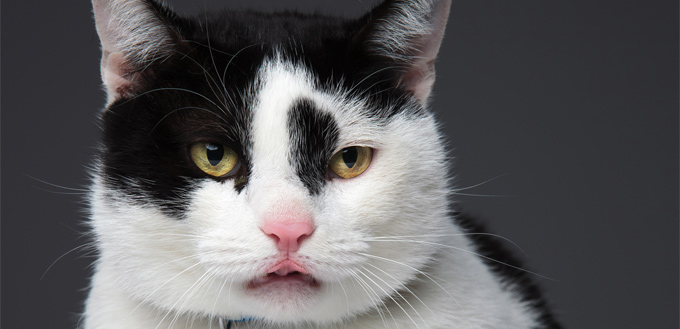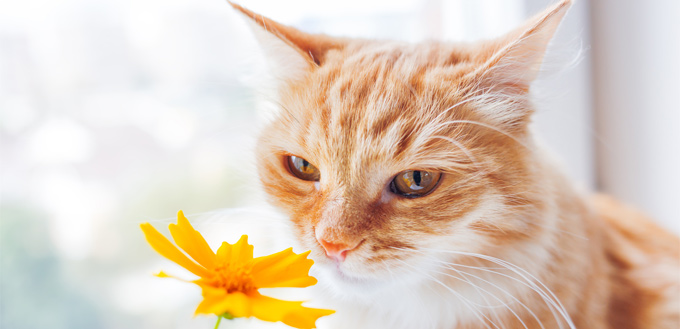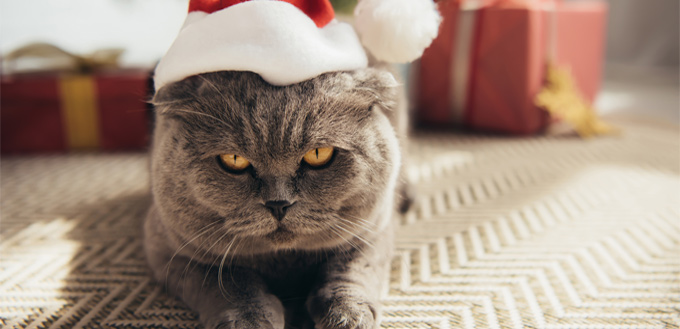Owning a cat can be wonderful, but it is not without its worries. Having a pet always comes with its difficulties owing to the fact that you cannot converse with them to understand fully what is wrong with them in when they are behaving weirdly or if they are unwell. It is unnerving sometimes as our first reaction will often be that we want to take our cats to the vet for a check up to ensure they are ok, but sometimes we ultimately find that we have been worrying about nothing.
One of the things that could cause us to worry, especially the first time we see it, is the Flehmen Response. In this guide to the Flehmen Response, we delve more deeply into a number of issues regarding the behavior so that owners can more fully understand what it is and why their cats display it. We also look closely at all the signals that mean your cat is simply exhibiting signs of the response so that owners can be certain of when they are behaving both normally and healthily without fear of needing to take them to the vet.

What Is The Flehmen Response?
For cats, one of the most prevalent idiosyncrasies that owners should not have to worry about is when their cat exhibits what is more widely known as the Flehmen response. It is a routine of facial expressions that can often be mistaken for a grimace or sneer. It is completely normal and is exceedingly common in cats as well as other animals like goats, horses, and tigers. The facial expressions are often conducted alongside open mouth breathing or standing in one place for a long period of time simply looking at the ground or the same spot.
Once most owners have seen it for the first time and concluded what exactly it is, they will often find it quite amusing as the Flehmen Response does cause cats to pull some very funny faces.
What Are The Signs of The Flehmen Response When Displayed In Cats
There are a number of signs that your cat is displaying the Flehmen Response. Once you have seen them, you can be sure of what your cat is doing so there is no need to worry about a bigger or more serious issue. They are:
- Their nose will begin to wrinkle
- Their mouths will curl up into something that looks a little like a grimace or sneer
- Their tongue will start flicking up into their mouths
- They will stand still in the same position for a few moments without moving
The Flehmen Response: In Detail
Those that are unsure of the Flehmen Response will probably start to become more aware of it when they notice their cat sneering or grimacing on a regular basis. In fact, this is because their upper lip starts to curl when they are exhibiting the response. In some cats, this curl will be more pronounced, and some even open their mouths at the same time (many don’t), so it can also be mistaken for panting.
From there, there is a number of signals that occur that are a little more difficult to see. For starters, their tongue will start to respond to whatever it is that has caused the Flehmen Response in them. It will mainly be down to a fascinating smell that starts to collect in your cat’s mouth. The tongue is then used to start flicking this smell or scent up to the vomeronasal organ. Humans do not have this organ, but it also helps cats (with their limited number of taste buds) taste food. It is can be known as the Jacobson’s organ too.

In flicking the tongue, and the corresponding smell, up to the vomeronasal organ your cat’s body is conducting both a smelling and tasting exercise at the same time to gather more information about what exactly it is in front of them that triggered the Flehmen Response in the first place.
The reason that they grimace, or curl their lip, is that this provides your cat with the best possible aperture for the smell to travel through and across, up to the Jacobson’s organ.
Given that they have a lack of taste buds, this process is incredibly important to cats. Their sense of smell is far better than ours as humans. While they lack taste buds, they have far more scent receptors which are why they have the extra Jacobson’s organ too. They need an organ that can cope with the extra information they gather. This is why the Flehmen Response can keep them mesmerized for so long. It is a way of them tasting the air, much like we would take a long time to eat something that tasted appetizing to us.
What is interesting is how this organ changes between the sexes. While both the female cat and male cat have the Jacobson’s organ, it is the male of the species that use it more than the female. This is down to the fact that the organ is used, alongside the Flehmen Response it engages in, to investigate and ascertain whether a female is sexually available. A cat’s sense of smell is so sensitive that they can smell the hormones in the urine that cats leave behind. However, if a smell is interesting enough, any cat will stop and engage in the Flehmen Response to conduct a thorough investigation of the scent they have picked up.
This is why cats may stop and display the behavior most often when we come in from the outside and there are new smells on our clothes and shoes.
More About the Jacobson’s Organ
The Flehmen Response is fairly alien to us as humans as we do not have the Jacobson’s organ that is largely responsible for why and how cats display the Flehmen Response in the first place. It is a specialized sensory organ that we may be able to understand, even if we can’t empathize with it given our not having one.
For starters, the vomeronasal organ is made up of two sacs that are totally filled with fluid. It is located at the roof of the mouth, which is why a cat goes to flick its tongue repeatedly as it helps direct scent there. The nasopalatine canal, which are two tiny ducts that are located just behind the teeth, is the route that connects the sacs to the nasal cavity so that the cat can smell with the nose too. The nasopalatine canal can be likened to a passageway for scents and smells.

However, we know that the cat does not smell through its nose as well as we do. This encourages the cat to gape during the Flehmen Response which is why a cat can look so odd to us as we gaze at one who is in the middle of displaying it. Due to the location of the Jacobson’s organ, or the vomeronasal organ, it is better for smells to be drawn in through and over a very wide mouth. The vomeronasal organ is then better able to analyze the smell and then transmits its findings to the brain.
Because we are completely lacking the very organ with which the cat smells, but importantly also tastes, it is impossible for us to understand this process fully. Vets often liken the Jacobson’s organ as the part of the body that enables a hybrid process of two our senses: taste and smell.
Why Do Cats Exhibit This Behavior
Owners, once they have noticed the Flehmen Response and are attuned to it, will start to notice it with more and more frequency. This is simply down to their ability to notice the behavior, not because the cat is increasing the frequency of the response.
And they do exhibit it quite frequently too. But why? Often it is to do with if owners have come in from the outside and carried in scents of other cats in with them. The Flehmen Response helps them to analyze the new smell that the owner has brought into the home. More specifically, when cats partake in the Flehmen Response, they are analyzing the pheromones that are contained within that scent or smell. Often, these are found within urine, but cats do not confine the reaction of the Flehmen Response purely to analyzing smells high in cat pheromone and hormones. They do so simply if a smell interests them. That being said, cats will display the Flehmen Response if they come into contact with other animals that have expressed their anal glands. This is down to the fact that what is secreted by the anal gland is incredibly rich in pheromones. The Flehmen Response ultimately helps them analyze and understand the smell more fully. This is also the case for why they may display it when walking past dirty clothes on the floor in their home, or if another cat has marked through the use of urine outside the home.
Owners will also see them display the Flehmen Response frequently if they move home. With all the new smells and scents that your cat has to investigate, the Flehmen Response is their most efficient way of doing so. The same can be said from when an owner returns from a day at work and all the new smells that they correspondingly bring in from the outside.
While vets and scientists understand and deduce that is both pheromones and smell that makes them display the Flehmen Response, they are only really sure of the link between pheromones and the response, not smells and the response. This is because of the logical, biological reasoning behind why cats would need to be able to smell pheromones. It is not clear why they have the same response simply too interesting scents that they pick up throughout the day that have nothing to do with other animals.
Bottom Line
The Flehmen Response is, therefore, a perfectly natural reaction for your cat that should not worry owners or cause them any concern. Accordingly, it is not a behavior that we should try to train out of cats displaying as it is simply a harmless, biological mechanism for them and a natural reaction. Trying to train them out of doing is both pointless and stressful for your cat, which, as a species, are prone to anxiety.
Plus it would be a particular shame for cats to be trained not to display such behavior when it is such a curious reaction. Their facial features often have to be seen to be believed during the Flehmen Response and, once an owner is assured that there is nothing wrong with their cat while they are displaying such a response, these facial features can cause much hilarity.
In all, there is absolutely nothing to worry about when cats stop and start to grimace over a particular point. It is simply the odd reaction that vets have called the Flehmen Response – a title that was developed through the German word Flehmen which means to curl one’s lip. While the scientific name can, to English speaking layman, sound a bit scary, there is really nothing to be concerned about while your cat performs it.
Just sit back, and enjoy!
Note: The advice provided in this post is intended for informational purposes and does not constitute medical advice regarding pets. For an accurate diagnosis of your pet's condition, please make an appointment with your vet.







